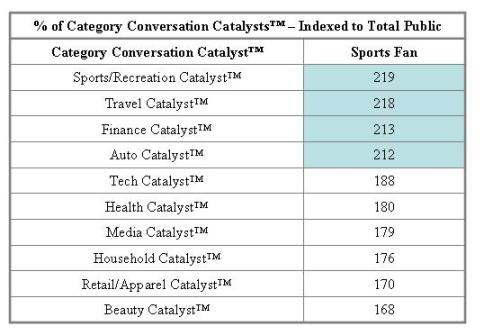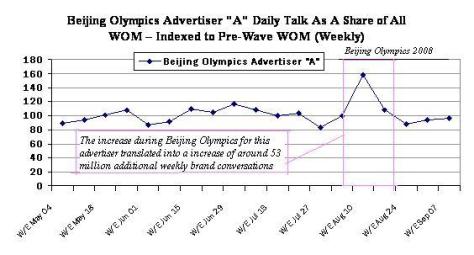Playing the Game: Why Sports Marketing Scores Points for Brands - Ed Keller - MediaBizBloggers

January is a great month for sports fans, and sports marketers: the NFL playoffs are about to begin and the Super Bowl season is nigh upon us, with CBS reporting that almost all of its ad slots have been sold; college bowl games have been building toward the crowning of a national champion this week; for tennis fans, the first major of the season will get started soon "down under." And as soon as January ends, the Winter Olympics are upon us.
For marketers, all of this begs the question: How much does it really pay to market to sports fans? Are they truly a special and engaged audience?
My firm's word of mouth tracking research documents clearly that sports fans are key consumers for brands to target: They are considerably more likely to start conversations with other people about brands and influence their decisions regarding those brands.
Sports fans engage in an average of 74 brand-related conversations each week – one-third more than the average American. Their propensity to talk up brands cuts across a wide variety of product and service categories. The leading category for word of mouth conversation by sports fans is media and entertainment, followed by food and dining brands. Other categories that inspire conversation include sports/recreation, beverages, retail/apparel, automotive, and telecom.
Not only do they engage in more talk, but these brand-related conversations by sports fans are apt to drive action. Specifically, a 52% majority of sports fans say their conversations lead to purchase intent. Translation: this is not just idle chatter; it pays for brands to stimulate conversation during sporting events.
Our research also shows that sports fans are two-thirds more likely than the average American to be word of mouth influencers, or what we call Conversation Catalysts™. Sports fans also greatly over-index against average consumers in their propensity to be category-level influencers in many areas, most notably in the sports/recreation (index = 219), travel (index = 218), financial (index = 213) and automotive (index = 212) categories.
Source: Keller Fay Group's TalkTrack®
What does this mean for individual advertisers? Research we have conducted with ESPN during the last NFL season finds that collectively, NFL advertisers on ESPN enjoyed 3 billion more word of mouth conversations among the network's male viewers than among non-viewers. As an example of what this means for an individual advertiser, one apparel brand enjoyed more than 90 million more WOM conversations among ESPN's male viewers than among non-viewers. With estimates by some that a conversation is worth 50 cents, that's a lot of marketing value for the advertiser. And the research shows clearly that the conversations link directly to the media plan – it's not a random occurrence.
What about special events, like the Super Bowl and the Olympics, both of which are right around the corner?
After the 2008 Super Bowl, advertisers enjoyed an appreciable increase – 16% – in daily WOM levels. That translated into a projected increase of 119 million weekly mentions for these Super Bowl advertisers. That surge in advertiser WOM was also represented in most demographics. The highest post-Super Bowl lifts were seen among teens, with a 34% daily WOM increase; young adults, with a 25% increase; and males, increasing by 27%.
Our research also shows that this WOM lift was largely a result of TV advertising. Following the 2008 Super Bowl, 23% of advertiser's WOM was driven by television commercials alone – a rise of 92% since before the big game day.
The Vancouver Winter Olympics will follow soon after, and advertisers should also expect big word of mouth results from those games. Winter Olympics fans are also nearly 2 times more likely to be consumer influencers, qualifying as catalysts in nearly every major advertising category at an index of around 200 versus average consumers. Additionally, Winter Olympics fans have more conversations about brands every week – 74 vs. 54 for total public – and one-in-four of these fans' brand mentions are driven by advertising. (NBC recently announced that Keller Fay will be monitoring the word of mouth effectiveness of Olympics advertisers for sponsors.)
Looking at data from the Beijing Olympics only bolsters the idea that the Olympics provide a potentially huge payday for advertisers. One major advertiser had a 26% increase in projected weekly branded conversations from before the Beijing Olympics to after, which translated into an additional 53 million weekly conversations for that brand.
Source: Keller Fay Group's TalkTrack®
So what does this all mean? Sports are a natural environment for generating word of mouth for brands. Fans tend to be influencers and engaged in brand WOM. The season-long commitment that fans make when they follow their favorite sports lends itself to an ongoing relationship between the fan and the brand sponsor; this is key, as word of mouth is all about relationships. And sports is a social topic that lends itself to co-viewing and conversation during and after games – conversations not only about the games themselves but about the brands that advertise.
Ed Keller, CEO of the Keller Fay Group, has been called "one of the most recognized names in word of mouth." The publication of Keller's book,The Influentials, has been called the "seminal moment in the development of word of mouth." Ed can be contacted at ekeller@kellerfay.com.
Read all Ed’s MediaBizBloggers commentaries at Ed Keller - MediaBizBloggers.
Follow our Twitter updates @MediaBizBlogger




